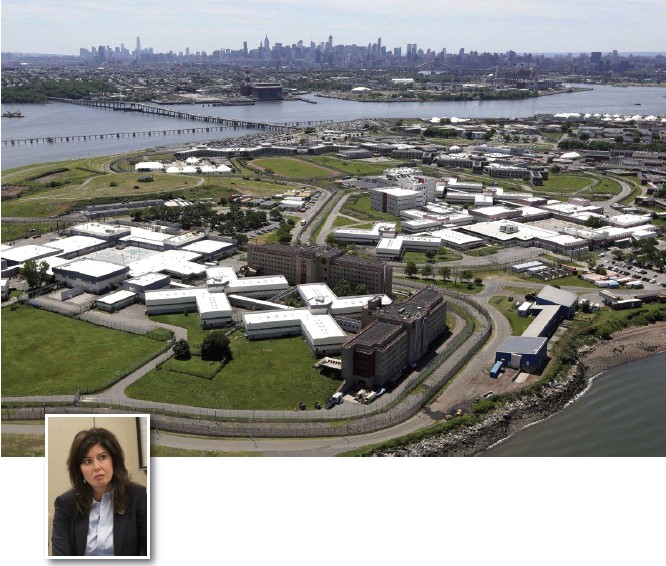If you think the Bill de Blasio/Elizabeth Crowley idea to close Rikers Island and open “community jails” seems absurd, you’d be correct. How we got to the point of even considering this may not be so obvious, so here we’ll examine how this has come about.
For years, developers have had their eyes on Rikers Island – 400 acres of land either adjacent to or a short walk to the water is a builder’s dream. The only problem is that it has a giant jail complex sitting on it.
Since Bill de Blasio took office, there has been a litany of problems at Rikers Island, from inmate deaths to workers smuggling in contraband. Being a phony progressive, Bill de Blasio naturally decided that rather than fix the problems at Rikers, he’d call for it to be closed down, which would not only appeal to his far-left base but would go a long way toward helping out his deep-pocketed developer donors. He appointed Judge Jonathan Lippmann to head a panel to study the issue. The commission was devoid of law enforcement or corrections experts, so of course their conclusion was that Rikers should be closed and vacated. The report even explored the use of the island for permanent housing.
This didn’t go over too well at first. Council Member Paul Vallone, during a 2016 City Council hearing, stated the following:
“We need a complete infrastructural overhaul of the island without a dream of thinking it’s going someplace else. Because there’s not a councilmember in the city that’s going to say, ‘put that facility in our district cause we really want it there.’ It’s never going to happen. Never.”
Indeed, no council member offered up their district as a sacrificial lamb at that time.
Then U.S. Attorney Preet Bharara decided to seriously investigate de Blasio, and it was looking pretty bad for the incumbent mayor. Some members of the Council started licking their chops at the prospect of open citywide seats being up for grabs. Public Advocate Letitia James was considered to be a frontrunner for mayor, leaving her position wide open. Council Member Crowley started telling people that she was considering a run for public advocate and she fundraised with the goal of amassing a giant war chest for that race.
To run citywide in a Democratic primary, you need to position yourself as far to the left as possible. That was why Elizabeth Crowley announced that as Chair of the Fire and Criminal Justice Committee, she was supporting the closure of Rikers Island.
Last year, she told the NY Times:
“You could make Rikers Island a community. Even if it were to have one jail on it. It’s not as if people are breaking out of the jail.”
She told NY1 in April:
“I worry about the people who work there and the inmates there. They are not safe on that island.”
The following statement comes directly from Elizabeth Crowley's campaign page:
“Moving jail operations to smaller, borough-based jails located near courthouses, which was DOC’s original practice, is a better plan than our City’s current detection [sic] centers on Riker's Island.”
Alas, all the dreams and schemes of starry-eyed politicians came to grinding halt when the U.S. Attorney's office announced it would not be bringing criminal charges against de Blasio earlier this year. James retreated to the safety of running for re-election as public advocate, and Crowley decided to exploit a loophole in order to run for a third term as council member (despite being opposed to the extension of term limits which was enacted in 2008 shortly before she took office and repealed by voters in 2010). The Queens County Democratic Machine endorsed Bill de Blasio for re-election, and Liz Crowley collected petition signatures for him to get on the ballot.
Again, from Crowley’s site:
“In Queens, the Queens House of Detention, which is adjacent to the Criminal Courthouse in Kew Gardens, has the capacity to hold the needed amount of detainees in our borough. The Council Member believes this jail could be renovated and reopened to serve as a more efficient location for those awaiting trial in Queens' criminal court. This smaller, contained facility would not only be safer for DOC staff and detainees, but save taxpayer dollars by cutting transportation and personnel costs.”
Crowley took a beating over the summer on the issue from both her constituents and her general election opponent, Robert Holden. Realizing how unpopular her stance was, on October 2nd, Crowley followed up with a letter signed by City Council Member Karen Koslowitz, who represents Kew Gardens in the City Council, along with several other Queens representatives who are running unopposed for re-election, supporting the choice of Kew Gardens as a jail site.
The first major problem with this letter is that it supports the closing of Rikers Island without knowing where the replacement jails will be sited. It urges the Kew Gardens location but it does not demand it. Shouldn’t voters expect their elected officials to act responsibly by knowing the consequences of closing the Rikers jail complex before they throw their support behind a plan to close it?
There are several problems with the Kew Gardens location itself. The first is that the Queens District Attorney’s office would like to expand into it. From DNA Info in 2014:
Brown said the city has been renting space down the street as workspace for about half of his prosecutors and police investigators since before he became the borough’s top law enforcement officer 25 years ago.
It's therefore not surprising that he and other court and NYPD officials want someone to take a sledgehammer to the wall and renovate the empty jail, turning it into a thriving office space for them and other social service agencies.
The idea was floated several times during the Bloomberg administration, but the cost-saving concept apparently fell on deaf ears without even an explanation why, sources said.
Why doesn’t Crowley, the Chair of the Criminal Justice Committee, support the request of the District Attorney’s office for more space in the interest of justice? It would seem like a logical position to take.
Next, the facility is way too small to handle the population that Queens is expected to be responsible for. There currently are 10 operational jails on Rikers Island holding 10,000 inmates in the system. The mayor said he is no longer considering Staten Island for the placement of a jail. That borough will not see one because of 2 reasons:
1) The 69-acre former Arthur Kill Correctional Facility was recently sold to de Blasio and Crowley crony Gina Argento of Broadway Stages for $7M (with the sale price being as much as $45 million below market value as per the Staten Island Advance) to facilitate its conversion into a soundstage.
2) According to de Blasio, the island doesn’t produce enough criminals to justify a jail there. For the criminals that do come from there, it is apparently acceptable to make their friends and family travel long distances and ok for taxpayers to pay for them to be shuttled back and forth to court, but not for inmates in the other 4 boroughs. (It’s more likely that Staten Island’s loud, vehement opposition to a jail changed his mind.)
At the current level and with Staten Island out of the picture, that would mean Queens would be responsible for hosting at least 2 jails that would house more than 2,000 inmates. The Kew Gardens facility was built to only house ~300-400 inmates. So there will either be extreme overcrowding, or there will have to be jails built elsewhere in Queens to handle the overflow. Even if the administration’s pie-in-the-sky effort to reduce the inmate population to 5,500 within 10 years is achieved, the jail and the site itself will still lack capacity.
Not mentioned in the Lippmann report or by Crowley is that Rikers also contains schools, medical clinics, recreational fields, chapels, gyms, drug rehab programs, grocery stores, barbershops, a bakery, a laundromat, a track, a tailor shop and a print shop. Where will these facilities and their workers go if the complex is shut down?
Meanwhile, despite Crowley’s assertion that “It’s not as if people are breaking out of the jail,” there was, in fact, an inmate who broke out of Riker's over the summer and the location of the jail on an isolated island is what led to his recapture. Why would we want inmates housed closed to schools, homes and businesses? An island is the logical place for them.
The de Blasio administration’s response to Crowley’s letter was:
“Expanding and reopening the Queens Detention Center would be an ideal first step and we have already started to take a hard look at this site to determine its feasibility.”
First step? It sounds like this will be one of several Queens jail locations. But where will the others be? DNA Info reported earlier this year that the City is already looking at a site in College Point. The closest site to our area mentioned in the report is on Maspeth Avenue in Brooklyn. De Blasio at this point has claimed that “no site is off the table” so you have to wonder if the administration will eventually zero in on the 78-16 Cooper Avenue location (it’s already been proposed as a hotel, homeless shelter and offices so a jail is not out of the question) or somewhere in West Maspeth. Elizabeth Crowley strangely was telling voters on primary day that she wanted to see jails “in industrial areas, not where people live” but one of the biggest manufacturing zones in the City is located within the district she represents, next to a residential community.
Not surprisingly, the issue of the Rikers closure will not be weighed in on officially by the City Council until after the election, when those leaving at the end of the year won’t care about blowback and all those re-elected will be in their final terms. It will be the unfortunate incoming members as well as the people of New York City that will bear the burden of bad post-election City Council decisions. We can only hope that in the coming years, studies will be conducted which will show that closing Rikers is economically infeasible and just a bad plan all around. A 400-acre island containing old jails and a lot of space is the perfect place to construct new state-of-the-art jails. As for limiting travel expenses, it would be wiser to build court facilities on the island that judges and attorneys would visit, or utilize technology to conduct video hearings. Just stop making up problems and excuses that do nothing for taxpayers but go a long way toward aiding real estate donors’ land grabbing schemes.



